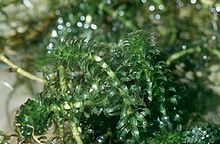| Hydrilla | |
|---|---|

| |
| Scientific classification | |
| Kingdom: | Plantae |
| Clade: | Tracheophytes |
| Clade: | Angiosperms |
| Clade: | Monocots |
| Order: | Alismatales |
| Family: | Hydrocharitaceae |
| Genus: | Hydrilla Rich. |
| Species: | H. verticillata
|
| Binomial name | |
| Hydrilla verticillata | |
Hydrilla (waterthyme) is a genus of aquatic plant, usually treated as containing just one species, Hydrilla verticillata, though some botanists divide it into several species. It is native to the cool and warm waters of the Old World in Asia, Africa and Australia, with a sparse, scattered distribution; in Australia from Northern Territory, Queensland, and New South Wales.[2][3][4]
The stems grow up to 1–2 m long. The leaves are arranged in whorls of two to eight around the stem, each leaf 5–20 mm long and 0.7–2 mm broad, with serrations or small spines along the leaf margins; the leaf midrib is often reddish when fresh. It is monoecious (sometimes dioecious), with male and female flowers produced separately on a single plant; the flowers are small, with three sepals and three petals, the petals 3–5 mm long, transparent with red streaks. It reproduces primarily vegetatively by fragmentation and by rhizomes and turions (overwintering), and flowers are rarely seen.[3][5][6][7] They have air spaces to keep them upright.
Hydrilla has a high resistance to salinity compared to many other freshwater aquatic plants.
- ^ Zhuang, X. & Beentje, H.J. (2017). "Hydrilla verticillata". IUCN Red List of Threatened Species. 2017: e.T167871A65905991. doi:10.2305/IUCN.UK.2017-1.RLTS.T167871A65905991.en. Retrieved 12 August 2023.
- ^ Flora Europaea: Hydrilla
- ^ a b Flora of Taiwan: Hydrilla Archived 2007-11-26 at the Wayback Machine
- ^ "Hydrilla". Australian Plant Name Index (APNI). Centre for Plant Biodiversity Research, Australian Government. Retrieved 15 March 2023.
- ^ Flora of NW Europe: Hydrilla verticillata Archived 2007-12-08 at the Wayback Machine
- ^ Blamey, M. & Grey-Wilson, C. (1989). Flora of Britain and Northern Europe. ISBN 0-340-40170-2
- ^ Huxley, A., ed. (1992). New RHS Dictionary of Gardening. Macmillan ISBN 0-333-47494-5.
